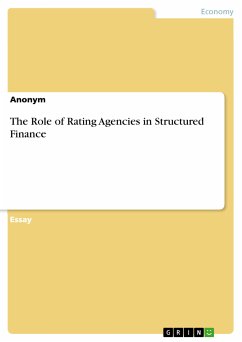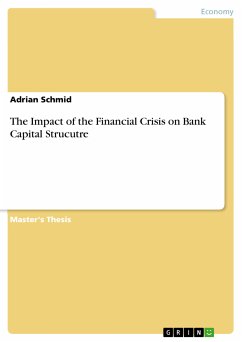
The Role of Rating Agencies in Structured Finance (eBook, PDF)
Sofort per Download lieferbar
Statt: 18,95 €**
16,99 €
inkl. MwSt. und vom Verlag festgesetzt.
**Preis der gedruckten Ausgabe (Broschiertes Buch)
Alle Infos zum eBook verschenkenWeitere Ausgaben:

PAYBACK Punkte
0 °P sammeln!
Essay from the year 2008 in the subject Business economics - Investment and Finance, grade: 2,2, European Business School - International University Schloß Reichartshausen Oestrich-Winkel, course: Introduction to Investment Banking, language: English, abstract: "There are two superpowers in the world [...] the United States and Moody's Bond Rating Service" - Thomas L. Friedman, NY Times The above statement by Thomas L. Friedman accentuates the importance of credit rating agencies (CRAs) in modern financial markets. As the past months have shown, Friedman's statement has held especially true f...
Essay from the year 2008 in the subject Business economics - Investment and Finance, grade: 2,2, European Business School - International University Schloß Reichartshausen Oestrich-Winkel, course: Introduction to Investment Banking, language: English, abstract: "There are two superpowers in the world [...] the United States and Moody's Bond Rating Service" - Thomas L. Friedman, NY Times The above statement by Thomas L. Friedman accentuates the importance of credit rating agencies (CRAs) in modern financial markets. As the past months have shown, Friedman's statement has held especially true for the role of CRAs in the structured finance market, where CRAs are currently being made responsible for playing an integral role in the emergence of one of the biggest financial crises of mankind: the subprime crisis. The role and the importance of CRAs in the structured finance market is the central topic of the following paper. To fully understand the impact of this issue on the worldwide financial markets, it is interesting to shed some light onto the dimensions of the structured finance market. The market is of considerable size given that outstanding structured finance securities in the United States amounted to 7.3 trillion US dollars in 2005 (Nomura, 2005) and have now grown to 9 trillion US dollars, which is more than two thirds of the United States GDP of 13.1 trillion US dollars in 2007 (U.S. Bureau of Economic Analysis, BEA, 2007). More-over, these outstanding structured finance securities represent more than 30% of the total outstandings in the U.S. bond markets (Nomura, 2005). As these figure reveal, it is not surprising that complications in the core of the huge market of structured finance could potentially lead to a major destabilisation of the entire worldwide financial markets; a risk that was obviously underestimated for a long time and finally lead to the genesis of the sub-prime crisis. The role of CRAs in the structured finance market has long been debated and the current financial turmoil has brought about concerns regarding such questions as to whether these credit ratings were based on wrong information and faulty or dated models, thereby questioning the significance of the system of CRAs. To enable a better insight into the functioning of CRAs and a justified testimony as to their performance, the following paper will dig deeply into the ambiguity of the rating process and the role of CRAs in structured finance.
Dieser Download kann aus rechtlichen Gründen nur mit Rechnungsadresse in A, B, BG, CY, CZ, D, DK, EW, E, FIN, F, GR, HR, H, IRL, I, LT, L, LR, M, NL, PL, P, R, S, SLO, SK ausgeliefert werden.













